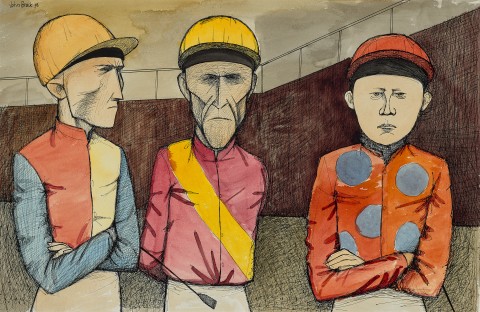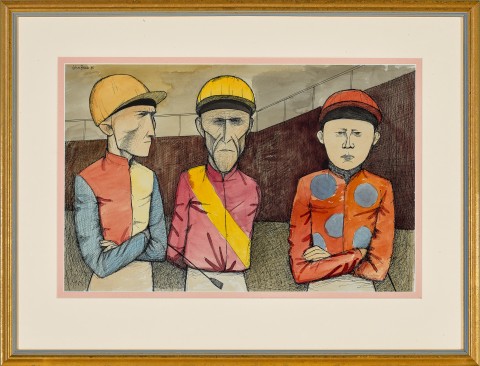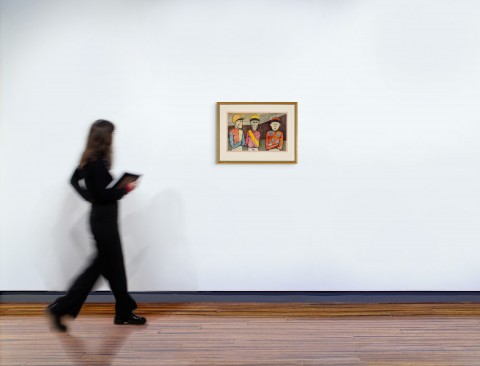THREE JOCKEYS, 1956
JOHN BRACK
ink and watercolour on paper
34.0 x 52.0 cm
signed and dated upper left: John Brack 56
Peter Bray Gallery, Melbourne
Douglas Carnegie and Margaret Carnegie AO, New South Wales, acquired from the above
Allan D. Christensen, California and Perth
Private collection, Perth, acquired from the above in 1981
John Brack: The Racecourse Series, Peter Bray Gallery, Melbourne, 5 – 15 November 1956, cat. 15
John Brack: The sport of kings and other paintings, Johnstone Gallery, Brisbane, 27 March – 8 April 1957, cat. 6
Shannon, M., 'The art collectors 4: Margaret Carnegie', Art and Australia, vol. 4, no. 1, June 1966, pp. 34, 36 (illus.)
Catalano, G., The Years of Hope: Australian art and criticism 1959 – 1968, Oxford University Press, Melbourne, 1981, p. 53 (illus.)
Lindsay, R., John Brack, A Retrospective Exhibition, National Gallery of Victoria, Melbourne, 1987, pp. 118 – 119
Grishin, S., The Art of John Brack, Oxford University Press, Melbourne, 1990, vol. 2, cat. p51, pp. 47, 201 (illus.)
Working two days a week as the art master at Melbourne Grammar School from mid-1952, John Brack was able to dedicate significant time to working in the studio. The following years witnessed a succession of solo exhibitions which included paintings that would, in time, rank among his most beloved and iconic. Men’s wear, 1953 (National Gallery of Australia) and The new house, 1953 (Art Gallery of New South Wales) featured in his first solo exhibition at Melbourne’s Peter Bray Gallery in October 1953; The bar, 1954 (National Gallery of Victoria) was included in a 1955 solo show and Collins St., 5p.m., 1955 (National Gallery of Victoria), was first shown in a one-person presentation in March 1956.
In November that year Brack held a second solo exhibition in Melbourne. The Racecourse Series comprised twenty-one works on paper (drawings in pen and ink and watercolour) and a small group of etchings which document a day in the life of the so-called sport of kings. Extending his practice of finding subject matter in the people and places around him, Brack had spent Saturday afternoons during the winter of 1956 at Flemington Racecourse, sketchbook in hand, observing and recording the characters and activities of the racetrack. Inspired by artistic predecessors such as Degas and Toulouse-Lautrec, who had previously explored this theme in memorable images, Brack’s experience of racing in 1950s Melbourne was however, not exactly as he had anticipated: ‘I was scarcely prepared for the almost total absence of gaiety. Artists in the 19th Century… dealt with horse racing in a more or less festive spirit. It seemed to have little or no relation to the solemn ritual which ruled Melbourne racecourses.’1
While the overall mood of the series and the attitude of the depicted figures is rather dour – rather like a Melbourne winter – Brack’s lively drawing emits a palpable energy as well as an immediacy that speaks of his direct experience of and engagement with the subject. There is also obvious delight in the vivid colours and designs of the jockeys’ silks, especially in works such as Three jockeys, 1956, where the subject provides the opportunity to play with combinations of colour and contrasting graphic patterns. Brack was an insightful observer of those around him, with a deep interest in human nature and behaviour, and in this work, he ruminates on the passing of time, charting the path from innocence to experience in the variously fresh and wizened faces of the jockeys.
Reviewing the exhibition in The Argus, critic Arnold Shore highlighted the ‘pungent commentary’ and ‘austere artistry’ of the series.2 Brack’s images clearly struck a chord with contemporary audiences and about half of the watercolours were sold, including The tree, which was purchased by the National Gallery of Victoria. Margaret Carnegie AO, a noted art collector and patron, purchased Three jockeys later and as her note on the back of the frame indicates, it was long cherished and enjoyed.
1. John Brack, ‘Brack on Brack’, Council of Adult Education, Discussion Group Art Notes, Melbourne, ref. no. A 401, 1957, p. 1
2. Shore, A., ‘Even our Art goes to the races’, The Argus, Melbourne, 6 November 1956, p. 14
KIRSTY GRANT


